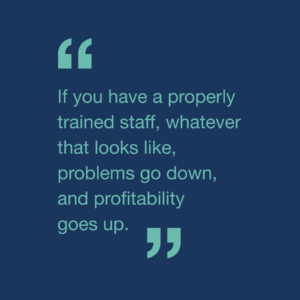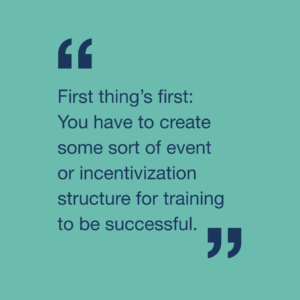6 Tips to Boost Contractor Training: How to Overcome the Training Struggle
November 22, 2022
Contractor training is critical for the success of a company. Use these tips to incentivize contractor training on your team.


Between solving customers problems in the field, running a successful business, supporting employees and going the extra mile to give back to the community, it can be hard to make time for contractor training. But staying up to date on the latest innovations, techniques, regulations and more is not only important—it’s essential to HVAC businesses and the health and reliability of the trade.
“The industry says we are somewhere around 65,000 technicians short of being fully staffed,” says Jose De La Portilla, Senior Manager of Education & Training at Rheem. “On top of that shortage, knowing that the average retirement age for technicians is around 65 but the average age of the industry is around 52 to 55, in five to 10 years, we are going to be hurting. Unless we develop a culture of training right now, contractors are going to fail because there just won’t be people to keep our crucial work going.”
Companies that prioritize contractor training not only have a leg up on what’s new in the industry but also provide better customer service, reduce employee turnover and are better equipped to adapt to industry changes. The fact is, a lack of training can have a big impact on business.
“If you aren’t training technicians, you are going to have bad installations and poor service work. That’s going to eat into your profitability by increasing warranty and callbacks,” De La Portilla says. “But we also can’t forget the intangible aspect of it. Every time your technician does something wrong, you are losing face with your homeowner.”
The question is: How can contractors make training a priority and motivate their teams dealing with an already busy schedule?
Here De La Portilla weighs in on how to make contractor training accessible, easy and enjoyable to benefit your team and grow your business.
 Build a company culture of training.
Build a company culture of training.
If training is important to your company—and it should be!—a growth mindset should be embedded into the core of your business. That means building regular training into your company’s culture, encouraging staff to participate and deliver on your commitment to learning year-round.
“A lot of people focus on training as a necessary evil, training just in time to solve problems,” De La Portilla says. “But really training needs to be something that focuses on preventing problems. If you have a properly trained staff, whatever that looks like, problems go down, and profitability goes up.”
Start small.
If you’re just starting out on your training journey, keep it simple.
“The key thing to remember is that you’ve got to walk before you can run and crawl before you can walk,” De La Portilla says. Consider hosting evening training sessions to start, including a meal to incentivize your staff to stick around. From there, perhaps the team attends training with your distributor.
“If you’re worried about busy seasons, find the shoulder season to start your training program. And then once you start to foster a training culture within the company, these technicians, installers and salespeople will go out of their way to take training to better themselves.”


One of the biggest reasons people neglect contractor training is because there often isn’t enough hours in a day for work and training. If you practice what you preach with creating a culture of training, you must also give employees the time, space and resources they need to get it done.
De La Portilla recommends giving employees time during the workday for training, but if you’re a small business that needs them on the clock, you must give them a reason to train off hours on their own time. Think of your training program as a three-prong approach: incentivization, recognition and reward.
“First thing’s first: You have to create some sort of event or incentivization structure for training to be successful,” he says. “That could be anything. Some contractors use it as monetary cash bonuses or swag. Some will create a tool program for their technicians that as you do more training, more funds are deposited that you can use to take your knowledge to the next level.”
Then, you must recognize your employees that participate in training. It could be as simple as a shoutout in a company meeting, or perhaps you start a badging culture in your company, where with every new training, employees receive a new badge.
“Lastly, you have to create a reward culture, which can be different than incentivization,” De La Portilla says. “A reward could be a positive event that takes place at the company, such as an annual party where you recognize the skills of others, or some other way to reward your team for going above and beyond.”
Try different training methods.
Nobody learns the same way, which means contractor training isn’t one-size-fits-all. Offering a variety of training methods, such as hands-on classes at Rheem’s Innovation Learning Centers and or online training through Rheem Academy, diversify training to accommodate various ways of learning.
Rheem also partners with Interplay Learning, which includes 3D simulation and virtual reality training. “It’s online, but it mimics real-world conditions where contractors can move the air conditioner around, take the panels off and add features. Then you take that and combine it with a virtual reality approach, and you’re in a 3D world using your real hands to work on equipment,” De La Portilla says. “It brings a unique perspective to learning, especially for young technicians who grew up in gaming.”
Incorporate teamwork.
Finding ways to train and learn as a team can not only ensure that everyone gets their training done but also connect your team on a more personal level. So, have your staff train your staff.
“Create a monthly meeting where different people in your organization teach the team something they do, not just related to product,” De La Portilla says. “Sometimes you’ll get greater buy-in on training if your employees know what other employees do, and it will create mutual respect as they all know they have value. We’ve got to utilize all employees to help and develop that learning culture.”
Make training flexible.
For busy employees, training flexibility is critical. Online training programs like Rheem Academy make it easy to train on-the-go, when and where you want.
“Rheem Academy allows you to train on your own time when, where and how you want,” De La Portilla says. “This includes product training courses, and, if you’re part of our Rheem Pro Partner program, you can log on to gain access to an entire suite of business-related training online, everything from marketing to sustainability and safety.”
Also keep in mind that after a long workday, your team may not want to go home just to sit at another desk. So, make use of the technology at your fingertips. “Our training is mobile responsive. Let your team train on their tablets and smartphones. After working eight hours today, they might not want to work at a desk anymore, but they might sit on that sofa when someone else in the family is watching TV to take training and learn and grow.”
At the end of the day, training is critical for the sustainability, stability and growth of a company. If you don’t have a training culture or program in place already, what are you waiting for?
Stay up to date on the latest in the industry at rheem.com/hvacknowzone.







